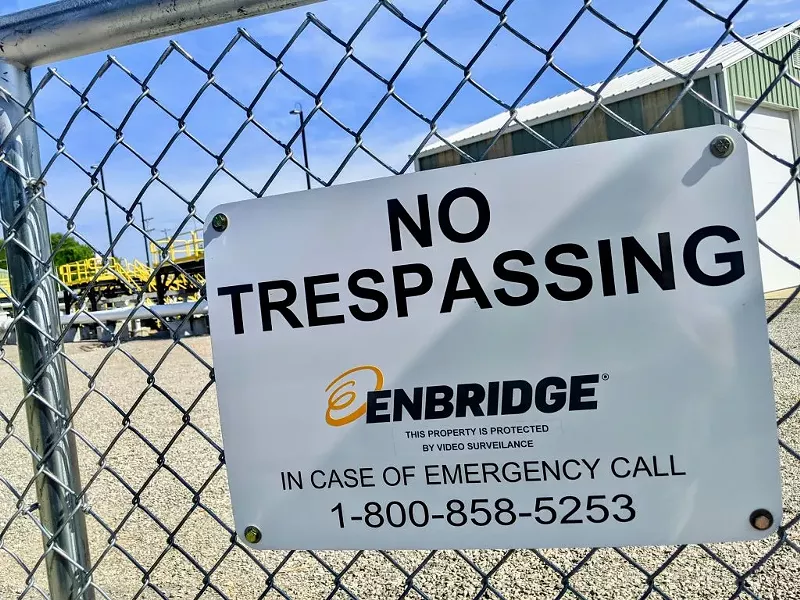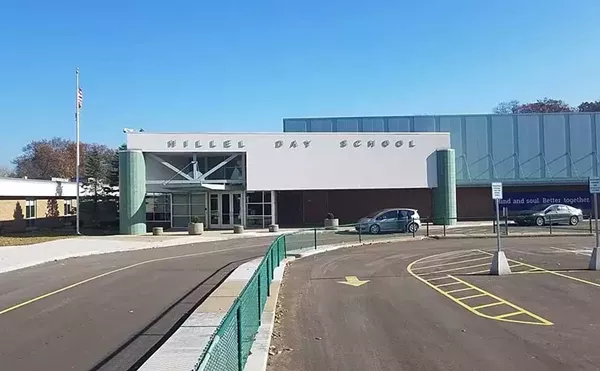Enbridge, Nessel fight over Line 5 pipeline in holding pattern
What's next in the Line 5 fight?

Audio By Carbonatix
[
{
"name": "GPT - Leaderboard - Inline - Content",
"component": "35519556",
"insertPoint": "5th",
"startingPoint": "3",
"requiredCountToDisplay": "3",
"maxInsertions": 100,
"adList": [
{
"adPreset": "LeaderboardInline"
}
]
}
]

When Democratic Gov. Gretchen Whitmer and Attorney General Dana Nessel took office in 2019, both having campaigned on decommissioning Enbridge’s Line 5, they ushered in a flurry of legal and regulatory battles over the embattled oil pipeline.
Two federal lawsuits could determine the fate of the 69-year-old Canadian pipeline that transports oil under the tumultuous waters where Lakes Michigan and Huron connect.
Two main questions have yet to be answered:
Who will determine whether Line 5 as it currently exists will be decommissioned? If the state wins a favorable decision, the existing Line 5 will be shut down. If Enbridge wins, the pipeline will continue to operate for years until the planned construction of a new, tunnel-encased pipeline is completed, when/if that project is approved.
What will happen to the “tunnel project,” which Enbridge is seeking immediate approval for but is facing pushback from environmentalists and tribal citizens?
With the help of Christopher Clark of Earthjustice, the Advance breaks down where things currently stand.
Line 5 court battles
There are currently two active lawsuits awaiting a decision in federal court. Both are overseen by U.S. Judge Janet Neff in the U.S. District Court for the Western District of Michigan.
Nessel’s 2019 suit teed up for jurisdictional ruling
Nessel v Enbridge et al was filed on June 27, 2019 in Ingham County’s 30th Judicial Circuit.
After Whitmer’s legal gambit to shut down Line 5 on grounds of revoking and terminating Enbridge’s 1953 easement was moved to federal court in November, the governor dropped the suit and made it clear that Nessel v Enbridge would be the state’s main play to decommission the dual pipelines.
Nessel’s 2019 lawsuit seeks to decommission Line 5 via public trust protections and other state laws. It had been on pause while Whitmer’s lawsuit played out but was scheduled to start up again in state court after Whitmer v Enbridge was dropped.
However, likely seeking to have their success repeated, Enbridge asked a judge to remove that lawsuit to federal court as well.
Generally speaking, defendants have a deadline of 30 days from the start of a case to move it to federal court. There are exceptions — like the plaintiff adding new claims or more defendants joining — but there is also typically a 30-day deadline from the day of an event that makes the case able to be moved.
But in many situations, a defendant cannot remove a case if more than one year has elapsed since the lawsuit was first filed.
Nessel’s lawsuit is now approaching three years since it was filed, making it unclear whether Enbridge even has the legal ability to successfully remove it to federal court after so long.
A flurry of legal filings over the last few months have led to decision time for Neff in that case. The federal judge will rule that either: a.) Nessel v Enbridge should remain in federal court, which would give the upper hand to the Canadian pipeline company; or b.) The lawsuit rightfully remains in the state court it was originally filed in and should continue in Ingham County.
If the case remains in federal court, the oil company would have a clear advantage as it intends to lean heavily on federal statutes and international commerce arguments to win.
Whitmer, Nessel and the Michigan Department of Natural Resources (DNR) would have an upper hand if the case is remanded back to the 30th Circuit Court, where they could point to state laws, public trust doctrine and Enbridge’s easement violations in a bid to force a Line 5 shutdown.
The last filing in this case was on Feb. 28.
Enbridge suit seeks to cripple state’s authority over Line 5
Enbridge v Whitmer et al was filed in federal court on Nov. 24, 2020 as a response to Whitmer filing her own lawsuit to shut down the pipeline.
This suit seeks a court ruling establishing that the Pipeline and Hazardous Materials Safety Administration (PHMSA), not the state, has sole regulatory authority over Line 5 regulation. A ruling in Enbridge’s favor in Enbridge v Whitmer would likely cripple the state’s effort to shut down the pipeline as the decision would find that only PHMSA has that power.
“A lot of [Enbridge’s] argument is premised on the notion that PHMSA and the pipeline safety act preempts everything — ‘you can’t do anything, state.’ And that’s just a flat-out misreading of the law,” Clark said. Earthjustice represents the Bay Mills Indian Community and three other tribes, and has submitted briefs on their behalf in the case.
So far, the federal agency housed under the U.S. transportation department has been quick to greenlight the company’s requests.
But both PHMSA and its parent department have undergone some administrative changes since 2020. Previously headed up by Elaine Chao, spouse of Republican U.S. Senate Minority leader Mitch McConnell (R-Ky.), The department of transportation is now led by the former South Bend Mayor Pete Buttigieg.
Buttigieg was one of four Democratic presidential nominees for 2020 who signaled public opposition to Line 5.
Leading PHMSA now as acting administrator is Tristan Brown, a Michigan-born attorney who served as U.S. Sen. Gary Peters’ (D-Bloomfield Twp.) legislative council from 2019 until 2021. He replaced controversial former President Donald Trump-appointed Howard R. Elliott.
The last filing in Enbridge v Whitmer was on April 7.
When both cases will receive rulings is “impossible to say,” Clark said.
Since the two separate cases are related, Neff may be weighing how one case may impact the other.
“You could imagine a decision coming in the two cases at the same time, but not necessarily,” Clark said. “…I wouldn’t be shocked if we get a decision on both of the cases at the same time.”
Tunnel project
Shortly before former Gov. Rick Snyder left office at the end of 2018, the Republican negotiated a deal with Enbridge to keep oil flowing through the Straits with a new, tunnel-encased replacement pipeline to the tune of about $500 million.
Snyder made sure that agreement was all but iron-clad before the new Democratic (and anti-Line 5) administration took over, using legislation passed by the GOP-led state Legislature that he quickly signed into law.
His statute creating the three-person Mackinac Straits Corridor Authority (MSCA) gave the panel full, independent authority to oversee Enbridge’s tunnel project in the Straits of Mackinac. This ensured Whitmer and Nessel could do very little to prevent the new Line 5 replacement segment and tunnel from being built.
Nevertheless, Nessel put up a fight to have Public Act 359 deemed unconstitutional. She was eventually defeated in court by Enbridge in June 2020 when a Michigan Court of Appeals panel upheld the law creating the MSCA. Nessel did not appeal the ruling to the Michigan Supreme Court.
Enbridge still faced three permitting hurdles to jump through before it can begin construction.
The company secured the first in January 2021, when the Michigan Department of Environment, Great Lakes and Energy (EGLE) granted permits for the project after nine months of review and more than 2,600 public comments. That decision was met with outcry from environmentalists and tribal citizens.
“We were very frustrated that EGLE did not give sufficient weight to the impact of this project on cultural and historic sites,” Clark said. “…This is an area where we feel like the tribal perspective is critical.”
The EGLE permits include a National Pollutant Discharge Elimination System (NPDES) wastewater discharge permit as well as permits related to wetlands impacts and bottomlands protection.
There are now just two more agencies to secure permits from before the tunnel project is fully greenlit.
Michigan Public Service Commission deliberates
The Michigan Public Service Commission (MPSC) has authority over the siting/routing of the Line 5 replacement segment to be routed through the planned tunnel, as well as the authorization for construction to start on the planned pipeline replacement segment.
Enbridge first submitted its application with the MPSC in April 2020, but that process was off to a rocky start as the company claimed it did not need the panel’s approval.
Enbridge had asked the commission to do one of two things: Either promptly grant the company’s application to construct the tunnel-enclosed pipeline, or declare that MPSC’s authorization is not necessary to start construction.
“First, Enbridge asked the commission to say that in essence, they didn’t really need the commission’s approval because Line 5 was approved back in 1953. That didn’t fly,” Clark said.
An administrative law judge ruled months later that the MPSC is indeed charged with granting or denying those permits.
“The commission said no, not only do you not get to bypass us, [but] we’re going to resolve this through what the commission calls a contested case process,” Clark said. All interested parties were invited to intervene, including Earthjustice on behalf of Bay Mills.
The first part of the contested case process worked through Enbridge’s request to limit the scope of the case.
Fast forward to spring 2021, and the MPSC made a ruling that environmentalists called a “mixed bag”: The panel will consider greenhouse gas emissions as part of its MEPA (Michigan Environmental Protection Act) analysis, marking a first in Michigan history, but the panel will strictly limit its review to the approximately 4-mile segment of Line 5 under the Mackinac Straits.
Clark says Earthjustice and other interested parties wanted the commission to consider all of the 645-mile pipeline that extends from the western U.P. to the Michigan border across from Sarnia, Ontario.
“Although of deep concern is the section that runs through the Straits, [Line 5 also] runs through hundreds of miles of ceded territory and crosses almost 300 waterways. And there have been leaks of, not a catastrophic nature, but there have been leaks across the length of the pipeline,” Clark said.
In January, there were nearly two weeks of virtual live hearings and cross examination. The last set of briefs were filed in March, and Clark says the MPSC has a “very voluminous” record of evidence to draw from.
All that is left now is for the MPSC to make its decision.
“We’re in a waiting pattern, and we’re going to obviously look at the decision very closely when it comes out,” Clark said.
Army Corps embarks on several-year review
The U.S. Army Corps of Engineers (USACE) is the last body needed to approve the tunnel project via the 404 Clean Water Act, which is the companion to EGLE’s review, and the Section 106 review related to the National Preservation Act.
Additionally, USACE announced last summer that the agency will be conducting a full analysis on the potential environmental impacts of a new tunnel-enclosed pipeline — much to the disappointment of Enbridge, who said it will lead to a “delay” on construction.
Jaime A. Pinkham, acting assistant secretary of the Army for Civil Works, announced the decision amid praise from environmental and business groups who oppose the project.
Pinkham is a citizen of the Nez Perce Tribe rooted in North-Central Idaho. Prior to his appointment to the Army Corps, he has been on record as being against the now-scuttled Dakota Access Pipeline, which had been set to transport oil through tribal lands.
The results of the environmental impact statement (EIS), which is still in the early stages of review, will ultimately inform whether the permit for the 404 Clean Water Act will be approved.
“The EIS process is probably going to take at least two years,” Clark said.
As for the Section 106 review, Clark says Earthjustice will be working with the Army Corps to make sure they take a “close look” at the impact of the project on historic and cultural sites in the area.
Originally published by Michigan Advance. It is republished here with permission.
Stay connected with Detroit Metro Times. Subscribe to our newsletters, and follow us on Google News, Apple News, Twitter, Facebook, Instagram, Reddit, or TikTok.





